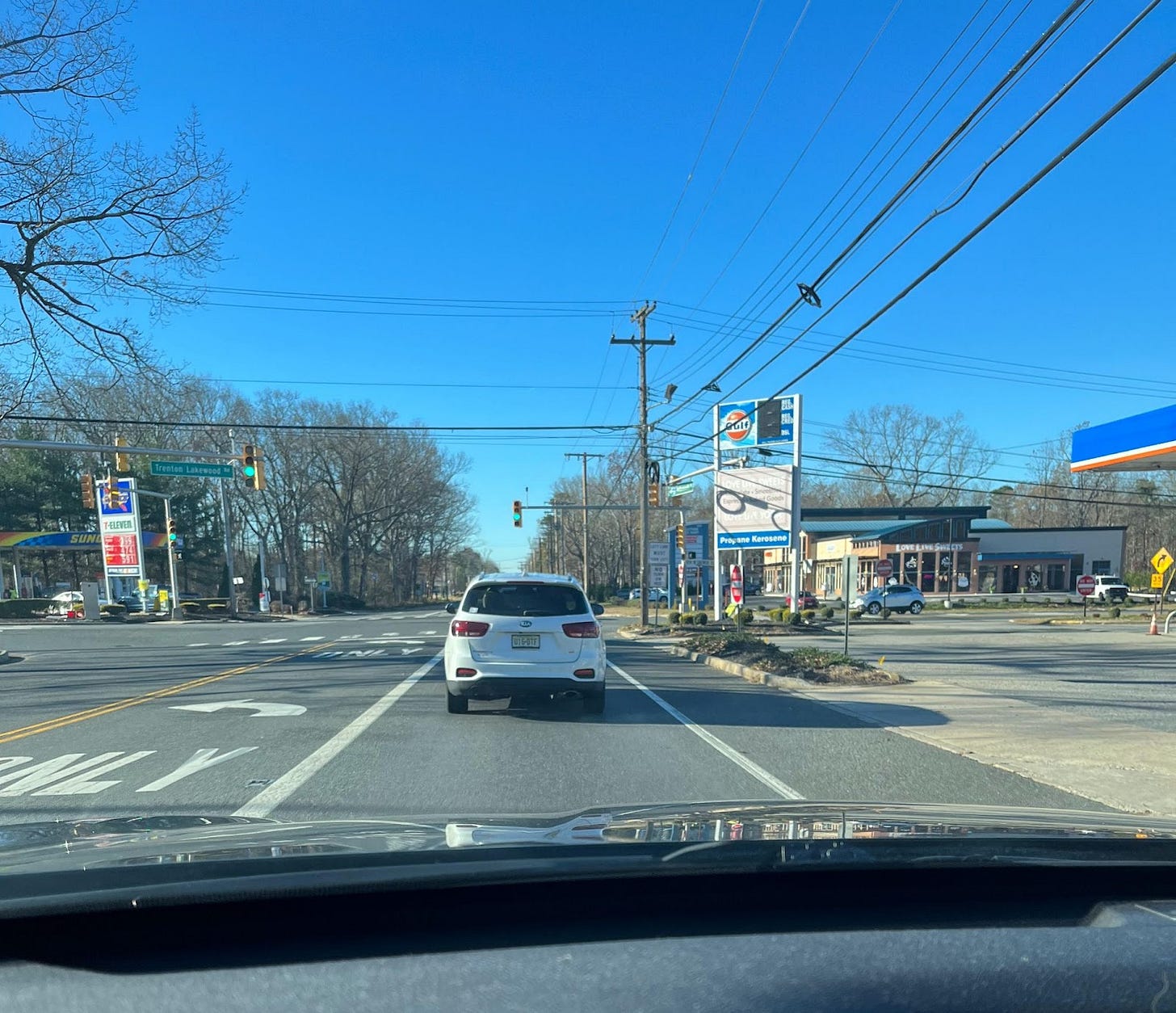I grew up in a non-place.
In my sprawling suburban hometown, my peers enacted a simulation of urban toughness while living in McMansions that were physically a simulation of rural tranquility. And so I came of age with the vague, uneasy suspicion that nothing around me was real, and that everything around me was a crude mockery of something else. This gnawing sensation was only assuaged by narcissistic delusions.
The suburb I speak of is Manalapan, New Jersey, but the United States is filled with non-places that tell a similar story, albeit with different flavors. Mine had an Italian flavor.
The mean, strip mall and gas station-lined streets of Central New Jersey
Manalapan is known for its Italian community (if “community” is understood in the vague and abstract sense). Most Manalapan kids, like me, had Italian-American Brooklyn-bred parents that fled southward from the big city to offer their children the American dream of placid domesticity. (Manalapan is one of the last stops on the NYC Italian Trail from Brooklyn to Staten Island to New Jersey, though this Trail is now extending further down to Florida).
On some subconscious level, Manalapan kids rejected this move.
My peers would play tough and affect a New York Italian accent outside the classroom, trying to pass it off as their natural persona away from the glare of the schoolmarms. (This was also during the original airing of the reality show Jersey Shore, so mass media was offering cues to follow).
In reality, we were all thoroughly whitewashed. We were, to varying degrees, docile and micromanaged children with overbooked schedules. Fist fights were rare, as were spontaneous after-school get-togethers in general, in our sterile and car-centric landscape. Still, in the playground and in the lunchroom, the attitudes that Italian Brooklynites left behind would find a new host in their bored and identity-confused suburban children.
Looking back, I can’t blame Manalapan kids for their act. They probably intuitively sensed that unlike Manalapan, Brooklyn had personality. It was a place.
My Italian immigrant ancestors trekked from Southern Italy to Brooklyn between the 1920s and the 1960s. They settled into a longstanding Italian-American mecca: the neighborhood of Bensonhurst.
By the 1970s, both my parents grew up in a community thoroughly suffused with the Italian language, iconography, customs, and culture, albeit with an American spirit of restless entrepreneurship. (The riposo culture of the motherland has no place in the City That Never Sleeps, even in the outer boroughs). For nearly a century, Bensonhurst was a vibrant Italian-American community with immense ethnic pride and a national reputation.
And then most Italians left.
They softened their accents to gain professional credibility, packed their bags, and took off, quickly replaced by waves of Chinese, Russian, and Middle Eastern immigration in the 1990s.
Since then, some of the old Italian cafes and theaters that lined Bensonhurst’s bustling streets have been retrofitted into a Chinese aesthetic, and some have become soulless chain stores and restaurants.
86th Street is Bensonhurst’s main commercial strip.
The sight of nonnas gossiping in lawn chairs along the street is far less common. When these moments do occur today, it is with an awareness that they are mimicking an old rite.
Does the Mediterranean man’s blood long for the piercing sunrays and climate of his ancestors? Does this explain the generational trek southward?
Unfortunately not. The reason why the Italians left Bensonhurst is because they have chosen to become white.
More unforgivable and more crucial to Italians becoming white than other explanations is the far-more recent and far-less-discussed Italian exodus across the Verrazzano Bridge, through Staten Island and into Mainland U.S.A. Bensonhurst Italians were late to the suburbanization trend.
While most white ethnics fled their cities in the 1950s and 60s, Bensonhurst Italians waited an extra 30 years. But unlike the Italians of many other communities, such as Newark, those who fled Bensonhurst don’t have race riots or rampant crime and violence to excuse their exodus. Nor do they have skyrocketing rent to blame — just their narrow vision of what it means to make it in America.
The move out of the Brooklyn townhouses and into the spread-out Jersey McMansions alongside other whites of all stripes was the final nail in the coffin for authentic Italian-American culture in the nation’s largest metro area.
A recent National Review article asserted that on the eve of The Sopranos’ 25th anniversary, “It’s Still Tony Soprano’s New Jersey”. This is true enough for a handful of Boomer shop-owners in North Jersey’s remaining walkable downtowns; everywhere else in the state, it’s now Meadow and A.J. Soprano’s New Jersey.
And so, subconsciously grieving a massive cultural death, my peers play-acted as Brooklynites.
I always saw right through their display. Yet, I just as eagerly adopted an even more contrived Italian persona of my own in my youth, to distinguish myself from the rabble’s artificial street edge. This took numerous forms.
I took pride in not being half-Italian, but the real deal: Italian on both sides. (I knew this mattered because in Goodfellas, only a full Italian can become a “made man”). I played up the fact that I was one generation closer to the old country than most other Italians, with a mother who still cooks the Feast of the Seven Fishes and is fluent in Italian (more accurately, an Italian-Neapolitan hybrid). My mother and I would mutter secret Italian jokes and remarks to each other in public. How many plain old white people or Jersey Shore wannabes can say they do that?
I was the top Italian-language student in my middle school. (A language — I should note — that my own immigrant grandparents did not really speak. They spoke the Neapolitan dialect their whole lives). I was on a mission to become fluent. I imagined myself moving to Italy after college.
I thought that white people jokes did not apply to me, and that my more-assimilated peers were not fit to breathe my air.
I became convinced that the genuine Italian culture of my immigrant grandparents, who died before I could ever know them, was refined and beautiful, and that the diluted Italian-American culture of the ‘Merigans who don’t speak a lick of Italian, both in my school and on Jersey Shore, was a sad dilution of it.
In retrospect, I am not sure who I was trying to impress or convince with my early adolescent Italian phase: My family? My classmates? Definitely myself, in part.
Like all phases, my Italian one eventually came to an end. I went to Italy in high school and met my distant relatives. I realized from the locals’ impressions of me that no amount of Italian classes could ever make me one of them. But by this time, I was not crushed. I had found new, obscure fixations upon which to latch my identity, none of which filled the persistent hole in my sense of self.
Merriam Webster’s word of the year for 2023 is “authentic.” The top definitions of the word are “not false or imitation,” and “true to one's own personality, spirit, or character.” If internet search trends are any indication of public opinion, people seem to care about authenticity more than ever. This emphasis on authenticity likely arises out of a sense of lack.
Growing up, my peers and I were inauthentic in our presentation of our Italian-American heritage. But we were just kids. And as privileged as we were in other respects, our upbringing was culturally impoverished, so we needed to overcompensate.
Now, as adults, we would consider these old childhood charades ridiculous. But I still see hometown acquaintances soothing their search for meaning and authenticity in other ways. Each Christmas, someone new receives a 23andMe DNA kit and eagerly shares the results to the world. The artificiality and banality of modern life leaves people stripped of a sense of identity, to the extent that some semblance of it must be recovered through political or commercial means — in this case, $100 ancestry packages.
I don’t have a solution to the problem of contemporary rootlessness. I don’t know what to do with my heritage, or what other Italian-Americans ought to either.
I’m trying to live a life that is real. After all, the desire to live a life that is meaningful and interesting is what triggered my tailspin into narcissistic Italophilia in the first place.
There’s a deep wistfulness that shines through my parents’ eyes when Bensonhurst or Italy enters the conversation. They see Italy with rose-colored glasses, as the origin of all that is beautiful and sacred. But their feelings about Bensonhurst, where they spent decades of their lives, probably count more. Despite their resolute stance that they had to flee to suburbia to give their family a proper yard, it’s clear that from their heartfelt attention to detail and manner of speaking about the past that they left something compelling behind in Brooklyn. They loved Bensonhurst for its grittiness, nosiness, and noise, even if they half-heartedly deny it.
Perhaps the takeaway is that when you find something real — whether or not it pertains to your heritage, and whether or not it conforms to contemporary standards of success — you should hold onto it. There was something real about Bensonhurst (and before Bensonhurst — Italy) that was too quickly discarded by too many.
I can no longer in good conscience LARP as an Italian, or even as a Sopranos-esque Italian-American, but I can arrange my life around finding things that are real and worth holding onto — some of which lie in my familial past, and some of which lie in the future which I must forge.
You can also check out AJ’s review of the Clash of the Female Titans. Subscribe to his Substack here.
Please consider signing up for a paid subscription to this page for more riveting content. If you’re new to Cracks in Pomo, check out the About page or read up on our Essentials. Also check out our podcast on Spotify, Apple, and YouTube and follow us on Instagram and Twitter.
MASA tortilla chips by Ancient Crunch is offering our followers 10% off their order with the promo code CRACKSINPOSTMODERNITY. Click here to redeem.
Photos by A.J. Fezza








